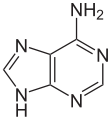xDNA
xDNA is a modified form of DNA with 8 nucleobases: the four natural bases A, C, G, and T, and four artificial modifications of these made longer by the addition of an extra benzene ring: xA, xC, xG, and xT.[1] A pairs with xT, C pairs with xG, G pairs with xC, and T pairs with xA, so the distance between the two halves of the double helix is consistently greater. The double helix is thus wider and has a longer pitch.
Experiments with xDNA are expected to provide new insight into the behavior of natural DNA. Also, the extended bases xA, xC, xG, and xT are fluorescent, and single strands composed of only extended bases can recognize and bind to single strands of natural DNA, which could make them useful tools for studying biological systems. The same research group also constructed widened DNA, called yDNA. xDNA is more stable when compared to regular DNA when subjected to higher temperature. xDNA is not capable of integrating into endogenous DNA and therefore must form its own distinct molecular helix. [2]
 |
 |
 |
 |
| Adenine | Thymine | Cytosine | Guanine |
 |
 |
 |
 |
| Size-expanded xA | Size-expanded xT | Size-expanded xC | Size-expanded xG |
References
- ↑ Lynch, Stephen R.; Haibo Liu; Jianmin Gao; Eric T. Kool (October 2006). "Toward a Designed, Functioning Genetic System with Expanded-Size Base Pairs: Solution Structure of the Eight-Base xDNA Double Helix". Journal of the American Chemical Society. 128 (45): 14704–14711. doi:10.1021/ja065606n. PMC 2519095
 . PMID 17090058.
. PMID 17090058. - ↑ Schwartz, Mark (5 November 2003). [news.stanford.edu/news/2003/november5/xdna-115.html "DNA double helix widened 20 percent for stabler molecule Scientist says creation is 'unlike any living system on Earth'"] Check
|url=value (help). Stanford Report. Stanford University. Retrieved 10 March 2016.